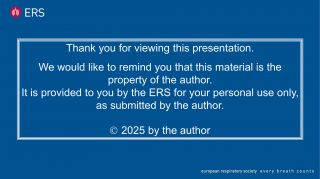12 June, 2025 | Online
17:00-18:00 CEST
Chair: Dr Hitasha Rupani (Southampton, United Kingdom)
Speakers: Dr Yet Hong Khor (Melbourne (VIC), Australia), Dr Magnus Ekström (Lund, Sweden)
Discussant: Prof. Peter M. A. Calverley (Liverpool (Merseyside), United Kingdom)
The Journal Club series is the latest addition to the wide variety of education-focused webinars on offer by ERS, including panel discussion and expert interview formats. Discover upcoming webinars.
Fees: Free for ERS members / €10 for non-members
Find out more about becoming a member
Overview
Despite widespread prescription, there is ongoing uncertainty about the optimal use and duration of LTOT in COPD, particularly in different patient phenotypes. Current guidelines offer limited clarity on the real-world impact on exacerbation risk and hospital burden, as well as whether longer daily use provides incremental benefits in survival or QoL. This session addresses these key gaps by reviewing new, high-impact evidence.
The webinar will focus on bridging this educational gap by featuring two recent high-impact studies:
1. Effects of Long-Term Oxygen Therapy on Acute Exacerbation and Hospital Burden: The National DISCOVERY Study
- Author & Speaker: Dr Yet Hong Khor
- Journal: Thorax (2025)
- Summary: A large real-world data analysis evaluating LTOT's role in reducing COPD exacerbations and hospitalisations. Offers insight into clinical outcomes and health system burden.
- Read article
2. Long-Term Oxygen Therapy for 24 or 15 Hours per Day in Severe Hypoxemia
- Author & Speaker: Dr Magnus Ekström
- Journal: New England Journal of Medicine (2024)
- Summary: A multicenter randomised trial comparing 24h vs 15h/day LTOT in severely hypoxemic COPD patients. It questions existing standards and offers new evidence on optimal duration.
- Read article
Each study will be presented in a 15-20 minute session, followed by a moderated 20-25 minute discussion. This segment will include contributions from invited experts, with additional support from the Chairperson to ensure a lively and comprehensive exchange of ideas.
Topics:
- Impact of LTOT on COPD exacerbations and hospital burden
- Optimal daily duration: 15 vs 24 hours of LTOT
- Real-world evidence vs randomized trial outcomes
- Identifying which COPD patients benefit most from LTOT
- Adherence and practical challenges with prolonged oxygen use
- Implications for current guidelines and clinical practice
- Gaps in evidence and priorities for future research
Format
One-hour webinar structured as follows:
- Welcome & Introduction - Hitasha Rupani (5 minutes)
- Presentation 1: Yet Hong Khor (15-18 minutes)
- Presentation 2: Magnus Ekström (15-18 minutes)
- Cross-Analysis & Panel Discussion - Peter Calverley, Hitasha Rupani (15-20 minutes)
- Audience Q&A and Wrap-Up (5 minutes)
Learning outcomes
Following this webinar, participants will be able to:
- Compare the clinical impact of LTOT as reported in randomised vs observational studies.
- Assess whether increasing daily LTOT duration from 15 to 24 hours offers added benefits.
- Identify patient subgroups that may benefit most from LTOT.
- Understand how LTOT use affects hospital burden and acute exacerbations in COPD.
- Critically appraise how new evidence should influence LTOT prescribing practices.
CME credit
An application for accreditation of this webinar has been made to the European Board for Accreditation in Pneumology (EBAP) for 1 CME credit per 1-hour attendance. If accredited, the CME credit will be granted upon attendance of at least 60 minutes during the live webinar only.
What is a webinar?
A webinar closely simulates a lecture-based teaching experience. The speaker can interact with the audience, just as in a classroom setting. During the webinar, you will be asked to share your opinion on issues related to the topic using interactive polls.
All participants will be able to hear the lecturer and see the slides throughout the presentation. As a participant you will be able to pose questions or discuss ideas with the other participants via the text chat facility and the speaker will respond to the questions via the microphone.
Login guidelines
More information will be communicated in due course.
- Please log in to the webinar 20 minutes before it is scheduled to commence. If you have any technical difficulties whilst trying to log in or during the session please contact e-learning@ersnet.org.
- Check Central European Summer Time.
- To achieve the best quality, we recommend to avoid downloading anything from the internet during your connection to the lecture and stopping all other programmes.
- Please also ensure that your audio settings are not set to mute and adjust the volume to a comfortable level.
Diseases/methods:
- Airway diseases
Target audience
- Pulmonologists and respiratory physicians
- Respiratory nurses and allied health professionals
- Clinical researchers
- Fellows and trainees in respiratory medicine
- Guideline developers and policy makers

